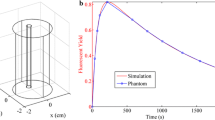Abstract
A large-scale fluorescence measurement captured by non-contact fluorescence molecular tomography imaging system is utilized to reconstruct the three-dimensional distribution of fluorescent probe in small animals. However, this makes the computational burden heavier and restricts the capacity of this technique. In general, the extracting area of interest is a universal method of increasing the effectiveness of the reconstruction. Hence, this study proposed permissible region extraction strategy by means of the node with the maximum energy at each projection. Simulation experiment and physical experiment demonstrated that the presented method can provide high-graded images at a shorter time cost. Furthermore, the stability of this method deserves investigation even under quite ill-posed conditions.







Similar content being viewed by others
Abbreviations
- FMT:
-
Fluorescence molecular tomography
- PR:
-
Permissible region
- PCA:
-
Principal component analysis
- SPECT:
-
Single-photon emission computed tomography
- CLT:
-
Cerenkov luminescence tomography
- PCCT:
-
Phase-contrast X-ray computed tomography
- RTE:
-
Radiative transfer equation
- DE:
-
Diffuse equation
- FEM:
-
Finite element method
- LE:
-
Location errors
- nRMSE:
-
Normalized root-mean-square error
- IVTCG:
-
Incomplete variables truncated conjugate gradient
- CGLS:
-
Conjugate gradient least squares
References
Deliolanis, N., Lasser, T., Hyde, D., Soubret, A., Ripoll, J., Ntziachristos, V.: Free-space fluorescence molecular tomography utilizing 360 degrees geometry projections. Opt. Lett. 32, 382–384 (2007)
Cao, X., Wang, X., Zhang, B., Liu, F., Luo, J.W., Bai, J.: Accelerated image reconstruction in fluorescence molecular tomography using dimension reduction. Biomed. Opt. Express 4, 1–14 (2013)
Razansky, D., Deliolanis, N.C., Vinegoni, C., Ntziachristos, V.: Deep tissue optical and optoacoustic molecular imaging technologies for pre-clinical research and drug discovery. Curr. Pharm. Biotechnol. 13, 504–522 (2012)
Dimarzio, C.A., Niedre, M.: Pre-clinical optical molecular imaging in the lung: technological challenges and future prospects. J. Thorac. Dis. 4, 556–557 (2012)
Song, X.L., Wang, D.F., Chen, N.G., Bai, J., Wang, H.: Reconstruction for free-space fluorescence tomography using a novel hybrid adaptive finite element algorithm. Opt. Express 26, 18300–18317 (2007)
Ntziachristos, V.: Going deeper than microscopy: the optical imaging frontier in biology. Nat. Methods 8, 603–614 (2010)
Guven, M., Reilly-Raska, L., Zhou, L., Yazici, B.: Discretization error analysis and adaptive meshing algorithms for fluorescence diffuse optical tomography—part I. IEEE. Trans. Med. Imaging 2, 217–229 (2010)
Zhang, J.L., Shi, J.W., Zuo, S.M., Liu, F., Luo, J.W., Bai, J.: Fast reconstruction in fluorescence molecular tomography using data compression of intra- and inter-projections. Chin. Opt. Lett. 13, 52–56 (2015)
Zhang, J.L., Shi, J.W., Cao, X., Liu, F., Luo, J.W., Bai, J.: Fast reconstruction of fluorescence molecular tomography via a permissible region extraction strategy. J. Opt. Soc. Am. A 31, 1886–1894 (2014)
Hu, Z.H., Chen, X.L., Liang, J.M., Qu, X.C., Chen, D.F., Yang, W.D., Wang, J., Cao, F., Tian, J.: Single photon emission computed tomography-guided Cerenkov luminescence tomography. J. Appl. Phys. 112, 024703 (2012)
Cao, X., Zhang, B., Wang, X., Liu, F., Liu, K., Luo, J.W., Bai, J.: An adaptive Tikhonov regularization method for fluorescence molecular tomography. Med. Biol. Eng. Comput. 51, 849–858 (2013)
Xie, W.H., Deng, Y., Wang, K., Yang, X.Q., Luo, Q.M.: Reweighted L1 regularization for restraining artifacts in FMT reconstruction images with limited measurements. Opt. Lett. 39, 4148–4151 (2014)
He, X.W., Liang, J.M., Wang, X.R., Yu, J.J., Qu, X.C., Wang, X.D., Hou, Y.B., Chen, D.F., Liu, F., Tian, J.: Sparse reconstruction for quantitative bioluminescence tomography based on the incomplete variables truncated conjugate gradient method. Opt. Express 18, 24825–24841 (2010)
Yi, H.J., Wei, H.N., Peng, J.Y., Hou, Y.Q., He, X.W.: Adaptive threshold method for recovered images of FMT. J. Opt. Soc. Am. A 35, 256–261 (2018)
Mohajerani, P., Hipp, A., Willner, M., Marschner, M., Arsic, M.T., Ma, X.P., Burton, N.C., Klemm, U., Radrich, K., Ermolayev, V., Tzoumas, S., Siveke, J.T., Bech, M., Pfeiffer, F., Ntziachristos, V.: FMT-PCCT: hybrid fluorescence molecular tomography—X-ray phase-contrast CT imaging of mouse models. IEEE Trans. Med. Imaging 33, 1434–1446 (2014)
Klose, A.D., Ntziachristos, V., Hielscher, A.H.: The inverse source problem based on the radiative transfer equation in optical molecular imaging. J. Comput. Phys. 202, 323–345 (2005)
Bai, J., Xu, Z.: Fluorescence molecular tomography[M]. Mol. Imaging 185–216 (2013)
Han, D., Tian, J., Zhu, S.P., Feng, J.C., Qin, C.G., Zhang, B., Yang, X.: A fast reconstruction algorithm for fluorescence molecular tomography with sparsity regularization. Opt. Express 18, 8630–8646 (2010)
Zhang, X.X., Zhang, J.L., Luo, J.W.: Reconstruction of in vivo fluorophore concentration variation with structural priors and smooth penalty. Appl. Opt. 55, 2732–2740 (2016)
Yi, H.J., Chen, D.F., Qu, X.C., Peng, K., Chen, X.L., Zhou, Y.Y., Tian, J., Liang, J.M.: Multilevel, hybrid regularization method for reconstruction of fluorescent molecular tomography. Appl. Opt. 51, 975–986 (2012)
Wang, B., Zhang, X., Hou, Y.Q., He, X.L., Yi, H.J., He, X.L.: Efficient image reconstruction for fluorescence molecular tomography via linear regression approximation scheme with dual augmented Lagrangian method. Multimed. Syst. 25, 135–145 (2019)
Yi, H.J., Zhang, X., Peng, J.Y., Zhao, F.J., Wang, X.D., Hou, Y.Q., Chen, D.F., He, X.W.: Reconstruction for limited-projection fluorescence molecular tomography based on a double-mesh strategy. Biomed. Res. Int. 2016, 1–11 (2016)
Oh, S., Kwon, S., Yun, J.H.: Image restoration by the global conjugate gradient least squares method. J. Appl. Math. Inform. 31, 353–363 (2013)
Acknowledgements
This work was supported by the National Natural Science Foundation of China under Grant (Nos. 11571012, 2016JM6025); China Postdoctoral Science Foundation under Grant (Nos. 2016M602851); Shaanxi Provincial Education Department under Grant (Nos. 2018JQ6099); Industrialization Project of Shaanxi Education Department under Grant (Nos. 16JF026, 17JF027).
Author information
Authors and Affiliations
Corresponding authors
Additional information
Publisher's Note
Springer Nature remains neutral with regard to jurisdictional claims in published maps and institutional affiliations.
Rights and permissions
About this article
Cite this article
Jiao, P., Yi, H., Hu, Y. et al. A permissible region strategy for fluorescence molecular tomography. Opt Rev 26, 523–530 (2019). https://doi.org/10.1007/s10043-019-00520-8
Received:
Accepted:
Published:
Issue Date:
DOI: https://doi.org/10.1007/s10043-019-00520-8




